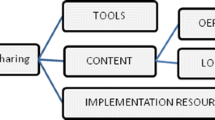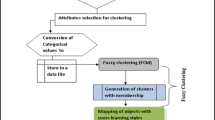Abstract
Currently the challenges in e-Learning are converging the learning content from various sources and managing them within e-learning practices. Data mining learning algorithms can be used and the contents can be converged based on the Metadata of the objects. Ensemble methods use multiple learning algorithms and it can be used to converge the Learning Objects from Learning Management Systems (LMS) and Knowledge Objects from Knowledge Management System (KMS). This can increase the performance of the learning system, especially when there is different content available from a variety of models. In this research, Data mining ensemble techniques are used so that an appropriate learning content is delivered to the learner. By converging, the learning content from various sources the Learning system pedagogies can also be revolutionized and a right learning path can be provided to the learners. This research work uses various classification techniques for converging and are evaluated using statistical measures.













Similar content being viewed by others
References
Agbonifo, O. C., Adewale, O., & Alese, B. K. (2012). Design of a Neurofuzzy-Based Model for Active and Collaborative Online Learning. Unpublished PhD Thesis, Federal University of Technology Akure, 7–8.
Aski, B. A., & Torshizi, H. A. (2009). The use of classification techniques to enrich e-learning environments. Age, 24, 49.
Baylari, A., & Montazer, G. A. (2009). Design a personalized e-learning system based on item response theory and artificial neural network approach. Expert Systems with Applications, 36(4), 8013–8021.
Carrion, J. S., Gordo, E. G., & Sanchez-Alonso, S. (2007). Semantic learning object repositories. International Journal of Continuing Engineering Education and Life Long Learning, 17(6), 432–446.
Castro, F., Vellido, A., Nebot, À., & Mugica, F. (2007). Applying data mining techniques to e-learning problems. In Evolution of teaching and learning paradigms in intelligent environment (pp. 183–221). Springer Berlin Heidelberg.
Chatti, M. A., Schroeder, U., & Jarke, M. (2012). LaaN: convergence of knowledge management and technology-enhanced learning. Learning Technologies, IEEE Transactions on, 5(2), 177–189.
Chellatamilan, T., & Suresh, R. M. (2012). Automatic classification of learning objects through dimensionality reduction and feature subset selections in an e-learning system. In Technology Enhanced Education (ICTEE), 2012 I.E. International Conference on (pp. 1–6). IEEE.
Chen, G. D., Liu, C. C., Ou, K. L., & Liu, B. J. (2000). Discovering decision knowledge from web log portfolio for managing classroom processes by applying decision tree and data cube technology. Journal of Educational Computing Research, 23(3), 305–332.
Davenport, T. H., & Prusak, L. (1998). Working knowledge: how organizations manage what they know. Harvard Business Press.
Dietterich, T. G. (2000). Ensemble methods in machine learning, In Multiple classifier systems (pp. 1–15). Berlin Heidelberg: Springer.
Dublin Core Metadata Initiative. (2012). Dublin core metadata element set, version 1.1.
Dunham, M.H. (2003), Data mining: introductory and advanced topics, Prentice-Hall.
Ellis, R. K. (2009). Learning management systems.
Gallenson, A., Heins, J., & Heins, T. (2002). Macromedia MX: creating learning objects. White paper. San Francisco: Macromedia.
Gil, A., de La Prieta, F., & López, V. F. (2010). Hybrid multiagent system for automatic object learning classification. In Hybrid Artificial Intelligence Systems (pp. 61–68). Springer Berlin Heidelberg.
Greenberg, L. (2002). LMS and LCMS: What’s the difference. Learning Circuits, 31(2).
Han, J., Kamber, M., & Pei, J. (2006). Data mining, southeast asia edition: concepts and techniques. Morgan kaufmann.
He, Y., Hui, S. C., & Quan, T. T. (2009). Automatic summary assessment for intelligent tutoring systems. Computers & Education, 53(3), 890–899.
Hogo, M. A. (2010). Evaluation of e-learners behaviour using different fuzzy clustering models: a comparative study. arXiv preprint arXiv:1003.1499.
Horton, W. (2001). Developing knowledge products. William Horton Consulting, Boulder, CO.
Horton, W. (2006). E-learning by design. SBN: 978–0–470-90002-4San francisco.Pfeiffer.
Hwang, G. J. (1999). A knowledge-based system as an intelligent learning advisor on computer networks. In Systems, Man, and Cybernetics, 1999. IEEE SMC’99 Conference Proceedings. 1999 I.E. International Conference on (Vol. 2, pp. 153–158). IEEE.
Hwang, G. J. (2003). A test-sheet-generating algorithm for multiple assessment requirements. Education, IEEE Transactions on, 46(3), 329–337.
Hwang, G. J., Huang, T. C., & Tseng, J. C. (2004). A group-decision approach for evaluating educational web sites. Computers & Education, 42(1), 65–86.
IEEE LTSC (2002). Learning Technology Standards Committee (LTSC) IEEE Standard for Learning Object Metadata. 1484.12.1–2002. http://ltsc.ieee.org/wg12/.
Jones, M. K. (1990). Domain knowledge representation for instructional analysis. Educational Technology, 30(10), 7–32.
Kaufman, L., & Rousseeuw, P. J. (2009). Finding groups in data: an introduction to cluster analysis (Vol. 344). John Wiley & Sons.
Khdour, T., & Salem, S. (2014) The effects of integrating knowledge management with E-Learning systems
Kotsiantis, S., Pierrakeas, C., & Pintelas, P. (2004). Predicting Students’performance in distance learning using machine learning techniques. Applied Artificial Intelligence, 18(5), 411–426.
Kotsiantis, S., Patriarcheas, K., & Xenos, M. (2010). A combinational incremental ensemble of classifiers as a technique for predicting students’ performance in distance education. Knowledge-Based Systems, 23(6), 529–535.
Lane, A., & McAndrew, P. (2010). Are open educational resources systematic or systemic change agents for teaching practice? British Journal of Educational Technology, 41(6), 952–962.
Lee, M. W., Chen, S. Y., & Liu, X. (2007). Mining learners’ behavior in accessing web-based interface. In Technologies for E-Learning and Digital Entertainment (pp. 336–346). Springer Berlin Heidelberg.
Liyanagunawardena, T. R., Adams, A. A., & Williams, S. A. (2013). MOOCs: a systematic study of the published literature 2008-2012. The International Review of Research in Open and Distributed Learning, 14(3), 202–227.
Lokaiczyk, R., Faatz, A., Beckhaus, A., & Goertz, M. (2007). Enhancing just-in-time e-learning through machine learning on desktop context sensors, In Modeling and using context (pp. 330–341). Berlin Heidelberg: Springer.
López, V. F., de la Prieta, F., Ogihara, M., & Wong, D. D. (2012). A model for multi-label classification and ranking of learning objects. Expert Systems with Applications, 39(10), 8878–8884.
Lykourentzou, I., Giannoukos, I., Nikolopoulos, V., Mpardis, G., & Loumos, V. (2009). Dropout prediction in e-learning courses through the combination of machine learning techniques. Computers & Education, 53(3), 950–965.
Merrill, M. D. (2000). Knowledge objects and mental models. In Advanced Learning Technologies, 2000. IWALT 2000. Proceedings. International Workshop on (pp. 244–246). IEEE.
Minaei-Bidgoli, B., & Punch, W. F. (2003, July). Using genetic algorithms for data mining optimization in an educational web-based system. In Genetic and Evolutionary Computation—GECCO 2003 (pp. 2252–2263). Springer Berlin Heidelberg.
Montazer, G. A. (2011). Learners Grouping in E-Leaming Environment Using Evolutionary Fuzzy Clustering Approach. International Journal of Information and Communication Technology. volume 3, number 1; page(s) 9 to 19.
Moreira-Matias, L., Mendes-Moreira, J., Gama, J., & Brazdil, P. (2012). Text categorization using an ensemble classifier based on a mean co-association matrix, In Machine Learning and Data Mining in Pattern Recognition (pp. 525–539). Berlin Heidelberg: Springer.
Mortimer, L. (2002). Learning objects of desire: Promise and practicality. Learning Circuits.Online. Available: http://www. learningcircuits. org/2002/apr2002/mortimer. html.
Najjar, J., Duval, E., Ternier, S., & Neven, F. (2003, November). Towards Interoperable Learning Object Repositories: The Ariadne Experience. In ICWI (pp. 219–226).
NSDL (National Science Digital Library) OAI Data Provider information under Services and Tools, https://wiki.ucar.edu/display/nsdldocs/OAI+Data+Provider
Qwaider, W. Q. (2011). Integrated of knowledge management and E-learning system. International Journal of Hybrid Information Technology, 4(4), 59–70.
Rahimi, H., Arbabisarjou, A., Allameh, S. M., & Aghababaei, R. (2011). Relationship between knowledge management process and creativity among faculty members in the university. Interdisciplinary Journal of Information, Knowledge, and Management, 6, 17–33.
Rokach, L. (2010). Ensemble-based classifiers. Artificial Intelligence Review, 33(1–2), 1–39.
Rowley, J. (2000). Is higher education ready for knowledge management? International Journal of Educational Management, 14(7), 325–333.
Saade, R., Nebebe, F., & Mak, T. (2011). Knowledge management systems development: theory and practice. Interdisciplinary Journal of Information, Knowledge, and Management, 6, 35–72.
Sabitha, A. S., Mehrotra, D., & Bansal, A. (2014a). Enhanced learning by extending metadata of learning objects with knowledge objects. International Journal of Education and Learning, 3(1), 1–12.
Sabitha, S., Mehrotra, D., & Bansal, A. (2014b). A data mining approach to improve re-accessibility and delivery of learning knowledge objects. Interdisciplinary Journal of E-Learning and Learning Objects, 10, 247–268.
Sabitha, S., Mehrotra, D., & Bansal, A. (2015a). Knowledge enriched learning by Converging Knowledge Object & Learning Object. Electronic Journal of e-Learning, 13(1), 3–13.
Sabitha, A. S., Mehrotra, D., & Bansal, A. (2015b). Delivery of learning knowledge objects using fuzzy clustering. Education and Information Technologies, 1–21.
Sampson, D. G., & Zervas, P. (2013). Learning object repositories as knowledge management systems. Knowledge Management & E-Learning: An International Journal (KM&EL), 5(2), 117–136.
Servin, G., & De Brun, C. (2005). ABC of knowledge management. NHS National Library for Health: Specialist Library.
Stathacopoulou, R., Magoulas, G. D., & Grigoriadou, M. (1999). Neural network-based fuzzy modeling of the student in intelligent tutoring systems. In Neural Networks, 1999. IJCNN’99. International Joint Conference on (Vol. 5, pp. 3517–3521). IEEE.
Strehl, A., & Ghosh, J. (2003). Cluster ensembles---a knowledge reuse framework for combining multiple partitions. The Journal of Machine Learning Research, 3, 583–617.
Syarif, I., Zaluska, E., Prugel-Bennett, A., & Wills, G. (2012). Application of bagging, boosting and stacking to intrusion detection, In Machine Learning and Data Mining in Pattern Recognition (pp. 593–602). Berlin Heidelberg: Springer.
Talavera, L.,Gaudioso, E. (2004). Mining student data to characterize similar behavior groups in unstructured collaboration spaces. In Workshop on artificial intelligence in CSCL. 16th European conference on artificial intelligence (pp. 17–23).
Tan, P.N., Steinbach, M., & Kumar, V. (2007). Introduction to Data Mining: Pearson Education (6th ed.), India. Chapter 9, page 624, ISBN: 978–81–317-1472-0
Tsai, C. J., Tseng, S. S., & Lin, C. Y. (2001). A two-phase fuzzy mining and learning algorithm for adaptive learning environment. In Computational Science-ICCS 2001 (pp. 429–438). Springer Berlin Heidelberg.
Valsamidis, S., Kontogiannis, S., Kazanidis, I., & Karakos, A. (2011). E-learning platform usage analysis. Interdisciplinary Journal of E-Learning and Learning Objects, 7(1), 185–204.
Wagner, E. (2002). Steps to creating a content strategy for your organization. Best of the, 103.
Wiley, D. (2002). Learning objects need instructional design theory. The ASTD e-Learning handbook, 115–126.
Wu, X., Kumar, V., Quinlan, J. R., Ghosh, J., Yang, Q., Motoda, H., et al. (2008). Top 10 algorithms in data mining. Knowledge and Information Systems, 14(1), 1–37.
Zakrzewska, D. (2008). Using clustering technique for students’ grouping in intelligent e-learning systems (pp. 403–410). Springer Berlin Heidelberg.
Acknowledgments
NSDL Metadata was harvested using OAI Data Provider form NSDL website. Our sincere thanks to NSDL.
Author information
Authors and Affiliations
Corresponding author
Ethics declarations
Conflict of interest
The authors declare that they have no conflict of interest.
Rights and permissions
About this article
Cite this article
Sabitha, A.S., Mehrotra, D. & Bansal, A. An ensemble approach in converging contents of LMS and KMS. Educ Inf Technol 22, 1673–1694 (2017). https://doi.org/10.1007/s10639-016-9516-7
Published:
Issue Date:
DOI: https://doi.org/10.1007/s10639-016-9516-7




